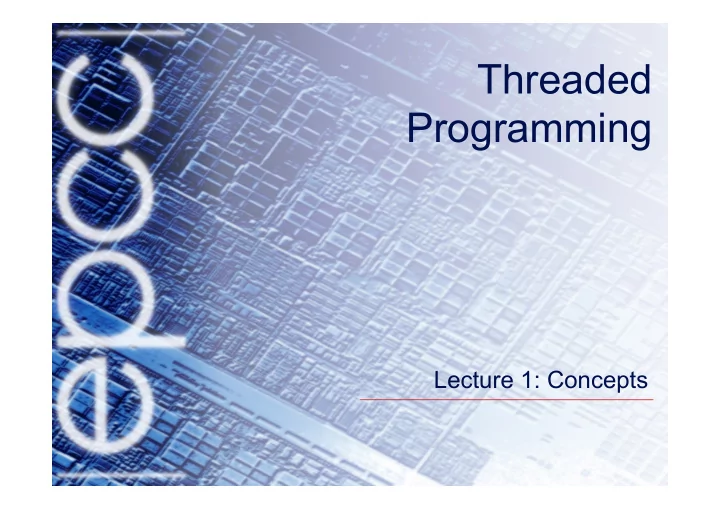

Threaded Programming Lecture 1: Concepts
Overview • Shared memory systems • Basic Concepts in Threaded Programming 2
Shared memory systems • Threaded programming is most often used on shared memory parallel computers. • A shared memory computer consists of a number of processing units (CPUs) together with some memory • Key feature of shared memory systems is a single address space across the whole memory system. – every CPU can read and write all memory locations in the system – one logical memory space – all CPUs refer to a memory location using the same address 3
Conceptual model P P P P P P Interconnect Memory 4
Real hardware • Real shared memory hardware is more complicated than this … .. – Memory may be split into multiple smaller units – There may be multiple levels of cache memory – some of these levels may be shared between subsets of processors – The interconnect may have a more complex topology • … .but a single address space is still supported – Hardware complexity can affect performance of programs, but not their correctness 5
Real hardware example P � P � P � P � L1 � L1 � L1 � L1 � L2 � L2 � Memory � Memory � 6
Threaded Programming Model • The programming model for shared memory is based on the notion of threads – threads are like processes, except that threads can share memory with each other (as well as having private memory) • Shared data can be accessed by all threads • Private data can only be accessed by the owning thread • Different threads can follow different flows of control through the same program – each thread has its own program counter • Usually run one thread per CPU/core – but could be more – can have hardware support for multiple threads per core 7
Threads (cont.) Thread 1 Thread 2 � Thread 3 � PC PC PC Private data � Private data � Private data � Shared data 8
Thread communication • In order to have useful parallel programs, threads must be able to exchange data with each other • Threads communicate with each via reading and writing shared data – thread 1 writes a value to a shared variable A – thread 2 can then read the value from A • Note: there is no notion of messages in this model 9
Thread Communication Thread 1 Thread 2 mya=23 Program mya=a+1 a=mya Private 23 24 data 23 Shared data 10
Synchronisation • By default, threads execute asynchronously • Each thread proceeds through program instructions independently of other threads • This means we need to ensure that actions on shared variables occur in the correct order : e.g. thread 1 must write variable A before thread 2 reads it, or thread 1 must read variable A before thread 2 writes it. • Note that updates to shared variables (e.g. a = a + 1 ) are not atomic ! • If two threads try to do this at the same time, one of the updates may get overwritten. 11
Synchronisation example Thread 1 Thread 2 load a load a Program add a 1 add a 1 store a store a CPU 10 11 10 11 Registers 10 11 11 Memory 12
Tasks • A task is a piece of computation which can be executed independently of other tasks • In principle we could create a new thread to execute every task – in practise this can be too expensive, especially if we have large numbers of small tasks • Instead tasks can be executed by a pre-exisiting pool of threads – tasks are submitted to the pool – some thread in the pool executes the task – at some point in the future the task is guaranteed to have completed • Tasks may or may not be ordered with respect to other tasks 13
Parallel loops • Loops are the main source of parallelism in many applications. • If the iterations of a loop are independent (can be done in any order) then we can share out the iterations between different threads. • e.g. if we have two threads and the loop for (i=0; i<100; i++){ a[i] += b[i]; } we could do iteration 0-49 on one thread and iterations 50-99 on the other. • Can think of an iteration, or a set of iterations, as a task. 14
Reductions • A reduction produces a single value from associative operations such as addition, multiplication, max, min, and, or. • For example: b = 0; for (i=0; i<n; i++) b += a[i]; • Allowing only one thread at a time to update b would remove all parallelism. • Instead, each thread can accumulate its own private copy, then these copies are reduced to give final result. • If the number of operations is much larger than the number of threads, most of the operations can proceed in parallel 15
Recommend
More recommend